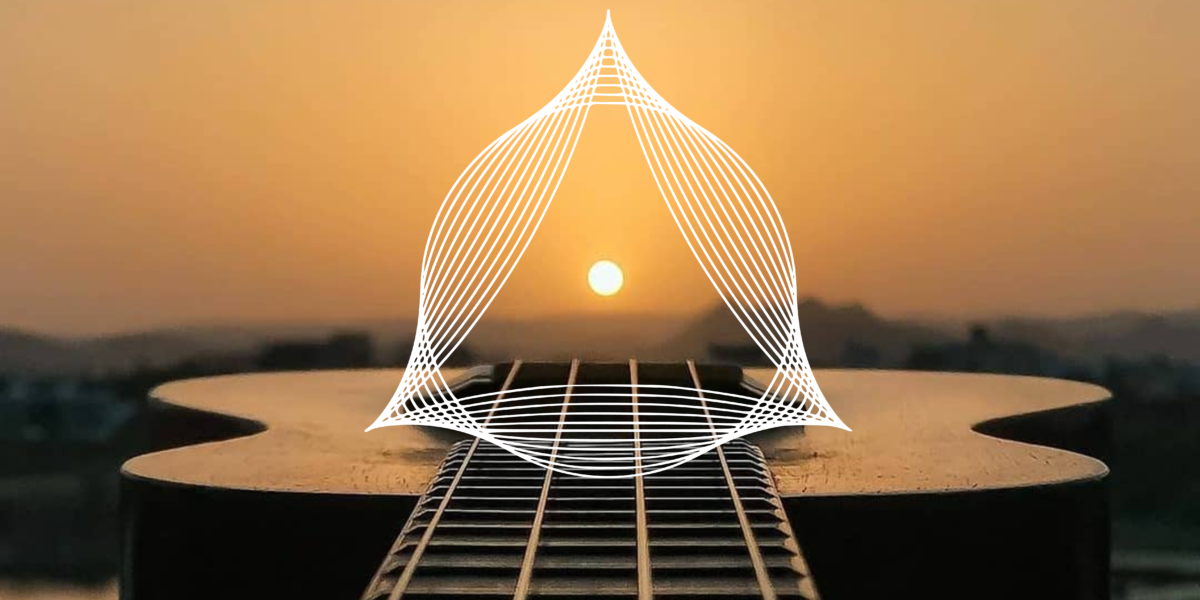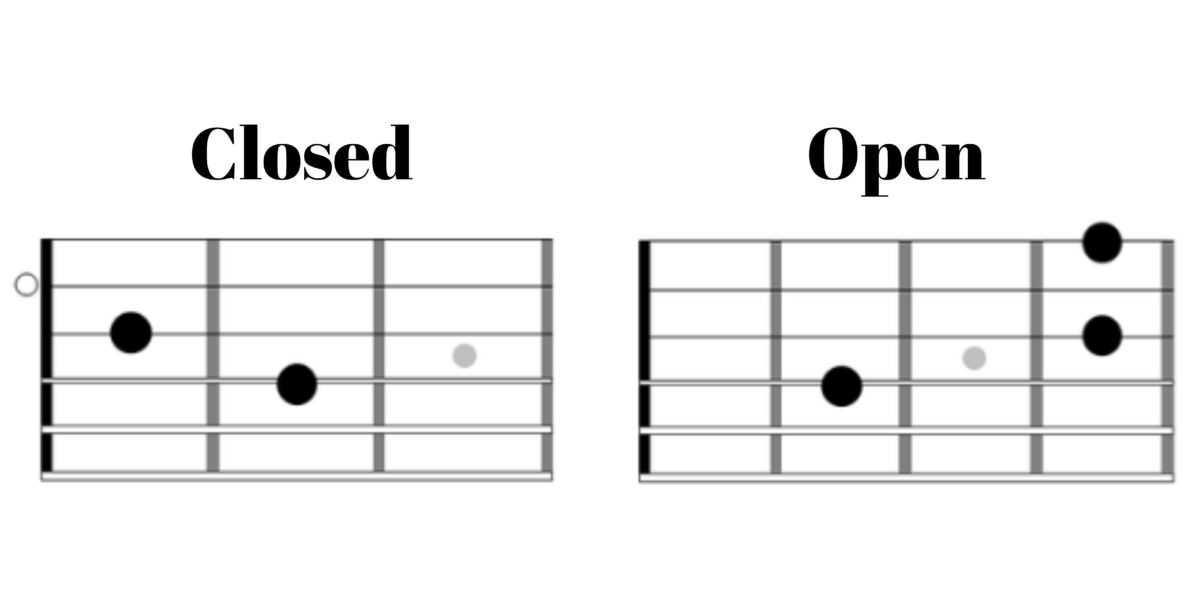Guitar Triads: Everything You Need To Know

This article covers the basics of guitar triads, why they are important for every guitarist to learn and how they can help with songwriting.
Guitar triads, like piano triads, make up a major portion of musical arrangements. The triad on guitar is a chord held with three fingers in different positions, the other notes being either open or muted.
Let’s take a deep dive into guitar triads.
What are guitar triads?
The most common type of triad is the major triad, which consists of a root note, a major third, and a perfect fifth.
You can play them in different inversions, or positions, on the guitar neck. Triads are important to learn as a guitarist because they are reliable building blocks for the budding songwriter.
To become a better guitarist in just minutes per day, download the Simply Guitar app.
Triads are typically built on a scale’s first, third, and fifth notes. For example, a C major triad consists of notes C, E, and G. When playing a G major triad, the root note is G, with the third in B and the fifth in D.
The majority of modern guitar music uses triads. If you listen to “Fire and Rain” by James Taylor, you can hear guitar triads throughout the entire arrangement. Guitar triads are so common that we often refer to them as chords.
There are close triads with notes that bunch together in an octave and open triads that span more than an octave.

Another important point is that triads can have more than three notes playing simultaneously. However, they are all variations of the three notes within the triad.
For instance, while playing an F major triad, your fretting hand holds more than three notes. They are all versions of F, A, and C.
Why should you learn guitar triads?
There are many reasons guitarists should learn triads. Building a triad is essential to understanding chord structures and how they work. Gaining a base understanding of chord voicing helps to visualize how the notes you want to play come together.
How chord shapes look and feel, how they interact as you move around the neck, and what triads work together to help jamming and songwriting.
If you are geared towards solo guitar playing, triads bring the voice of the guitar out for you to sing with—making for great singer/songwriter vibes.
When jamming with a band, knowing guitar triads is a necessity. You don’t need to be a music theory wiz to keep up with the band if you know your triads and how they work in different arrangements.
Guitar triad shapes are also easy to play for beginners as they are only made up of three notes. Much easier than playing a proper bar chord which requires considerable dexterity and hand placement.
Major and minor guitar triads.
Triads are three-note chords that you can play in various ways. Major and minor triads are the two most common types of triads. Major triads have a bright sound, while minor triads are melancholy or moody.
To create a major or minor triad, stack two-thirds on top of a root note. Below, we cover the major and minor triads in the first position.
G Major Triad
To play the G major triad, your fretting hand must be in one of the G positions on the guitar neck.
Playing in the first position, on the third fret, the middle finger on your fretting hand holds the G note on the bottom E string. This is the root note.
Next, your index finger holds the B note on the A string. This is known as the third.
Finally, your ring finger holds the D note on the top E string. This version of the G chord is one of the most played major guitar triads.
C Major Triad
The C major triad is similar to the G but slightly different. Your middle finger holds the C note on the A string, while your ring finger holds an E note on the D string. C is the root note, and E is the third.
Your index finger holds the G note creating the perfect fifth. With that, you are playing the C major triad. The G and C major triads work very well in succession.
A Major Triad
This guitar triad requires proper hand positioning and can be a little challenging to play for the beginner guitarist. However, fret not. Once you get this chord shape down, your muscle memory helps you with similar chords all over the neck.
The shape of this chord is handy for any guitar player. Playing the A major triad requires your index, middle, and ring finger to hold three notes on the same fret.
Your index finger holds the D string, while your middle and ring fingers hold the G and B strings on the second fret.
Now you can play the A major triad chord. This chord shape can be moved all along the neck of the guitar and is exceptionally effective in Blues and Jazz musical arrangements.
E Major Triad
The E major triad is likely the first chord any beginner learns on the guitar. The key of E, in general, is something many music lovers…love. Its moody, dynamic, and colorful nature pulls in listeners from all walks of life.
Playing the E major triad is friendly to those players who haven’t mastered hand positioning. The mechanics of this chord are likely what makes it a go-to for many novice guitarists.
You start by holding your middle finger on the A string in the second fret, your ring finger holds down the D string in the second fret, and your index finger holds the G string on the first fret.
The root note is the open E string in this chord.
F Major Triad
Playing the F major triad can be tricky for beginner guitarists, but practice always prevails. To play this triad, hold the E string with your index finger on the first fret, the G string with your middle finger on the second fret, and the A and D strings with your ring finger and pinky finger on the third fret.
While it may seem confusing that holding four notes makes up a triad, this is indeed a triad.
G Minor Triad
To play the G minor triad, use your index finger to bar or cover all six stings on the third fret. Then use your ring and pinky finger to hold down the A and D strings.
You can also simply mute the B, G, and high E strings with your index finger to isolate only the bottom end of the triad if barring the chord is too difficult. You can also use this for effect in songwriting.
C Minor Triad
The C minor triad is identical to the G minor triad. The only difference is holding all of your fingers in the same position on the same frets, starting with the A string instead of the E string.
A Minor Triad
Playing the A minor triad is easy for beginners. It’s almost identical to the A major triad, only you hold the D and G strings down with your middle and ring finger on the second fret with your index finger holding down the B string.
This chord is a favorite among songwriters with a darker tone, and you can easily augment it while playing to add a layer of complexity to your music.
E Minor Triad
This is often the first chord a beginner guitarist learns. Both because it is probably the easiest chord to play and because of the tone’s rich, haunting nature.
You hold the A and D strings with your index and middle finger to play the E minor triad.
F Minor Triad
Another easy-to-play chord, the F minor triad, is played by holding the E and A strings with your index and middle fingers on the fourth fret of the guitar neck. Though this is a minor chord, it has a brighter tone than the others and makes for a great change-up from darker tones.
How to use guitar triads.
Using guitar triads is quite simple. Start by picking a triad that you like, such as the E minor, and then string it together with other triads to find the arrangement you like. Gregory Alan Isakov’s powerful song “San Luis” is an excellent example.
In this song, you hear him expertly alternate between major and minor triads. The chords E minor and A minor essentially hold the song together with the C and G major triads, bringing a touch of hope to the dark tone of his arrangement.
While experimenting with different triad pairings, don’t forget that you can change between major and minor. So if you get stuck while writing a song, try changing things up and throw in a major triad where there was a minor or vice versa.
Beginner tips to practice guitar triads.
When practicing guitar triads as a beginner, starting with the easiest ones for you to play certainly won’t hurt. Most beginners find chords such as Em, Am, C, and G fairly easy to play.
Don’t fall into the trap of only playing what is easy for you. Try putting in the chord you don’t like when writing songs. You find it was the missing chord that you needed to finish your song.
Try muting some strings for effect instead of playing every chord with all of its notes voiced. You may find it adds the emotion you want to achieve, or not—it certainly won’t hurt.
Guitar triads takeaways.
As you can see, triads, chords, guitars, and songwriting are closely linked. Take a listen to some of your favorite songs, look up the chords and give them a try.
You may find that most modern music is based around guitar triads.
Are you a beginner guitar player that wants to take your practice to the next level? Download the Simply Guitar app. It has excellent features made with the beginner in mind!









